#e commerce delivery service
Text
#react native app development Services in Noida#react native app development company#React native app development Services#Flutter App Development Services#Flutter App Development Company#eCommerce Application Development#eCommerce Application Development Company#eCommerce app development services#eCommerce App Development Company#Custom E-Commerce App Development#Custom Software Development Services#Best software development company#Best software development company in noida#Custom Flutter App Development Company#mobile app development company near me#app development companies near me#app development company near me#mobile app development company#app development companies#mobile app development company in India#app development company in Chennai#mobile app development company in Chennai#flutter app development company#mobile app development company in Bangalore#food delivery app development company#Mobile App Development Company near me#Mobile App Development Company#software development company in india#Cloud Consulting Services in Noida#Cloud Consulting Services
0 notes
Text

Top it consulting firms in usa
#web development services in usa#web development companies in usa#website design companies in usa#website development company in usa#web design company usa#web development usa#mobile app development services in usa#top app development companies in usa#app development companies in usa#app development services usa#mobile app development company in usa#top mobile app development companies in usa#mobile app development usa#software development services#software development agencies#custom software development agency#software development companies#custom software development companies#software development companies near me#software development companies in usa#ecommerce agency#digital commerce agency#digital commerce agencies#ecommerce agency near me#ecommerce platforms for small businesses#e commerce platforms list#ecommerce digital agency#cloud services provider#software development company#continuous delivery
0 notes
Text
Choose C3X, Your Ecommerce Delivery Service Leader!

Seamlessly connect with your customers through C3X, the forefront leader in e-commerce delivery service! Our tailored solutions cater to the specific needs of online businesses, ensuring swift and secure delivery worldwide. With C3X, enjoy hassle-free order fulfillment and reliable shipping that enhances your customer experience. Trust our expertise to optimize your e-commerce logistics and drive your business forward. Experience the ease and efficiency of e-commerce delivery with C3X by your side!
visit : https://www.c3xpress.com/services/ecommerce-delivery-service-in-dubai.html
0 notes
Text
#Online delivery service#Launching delivery business#Start delivery service#Taking business online#Business delivery solutions#E-commerce delivery#Online business setup
0 notes
Text
Understanding fast, reliable deliveries with MyAce Courier and Services Pvt. Ltd, renowned as the best courier service in India. Our extensive network ensures timely and secure transportation of your parcels nationwide. Trust us for unparalleled efficiency and customer satisfaction. Choose MyAce for all your courier needs and enjoy seamless delivery solutions.
#courier services in india#courier service franchise#courier company in india#business courier service#best courier service in india#courier service company#courier franchise apply online#courier company franchise#courier business franchise#courier agency franchise#professional courier franchise#cheapest courier service in india#courier franchise in india#best courier franchise in india#ecommerce courier franchise#e commerce delivery franchise
1 note
·
View note
Text
#dispatch management solutions#dispatch solution#packaging solutions in noida#dispatch logistics solutions#delivery service in noida#dispatch#logistics solutions#Courier Company in Noida#Courier Agency in Delhi#E-commerce Courier Services in Delhi
0 notes
Text

say goodbye to the complexities of shipping.
Now Hassle-Free Delivery PAN India with Shipybox.
Start shipping your heavy load @Rs.7/per kg*
Over 30000+ PinCodes
Best E-Commerce Logistics Services Over 30000+ PinCodes
#Shipybox#shipping#fulfillment#logistics#delivery#shippingsoftware#shippingcosts#shippingoptions#CourierServices#EfficientShipping#VolumetricWeight#SafeDelivery#Best E-Commerce Logistics Services Over 30000+ PinCodes
0 notes
Text
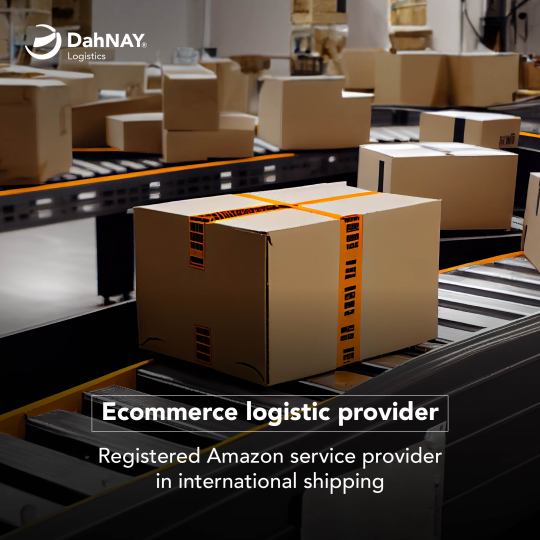
E-Commerce Logistics Service | International Freight Forwarder - DahNay Logistics
Effortlessly broaden your global e-commerce footprint using our specialized Ecommerce Logistics Services. We grasp the intricacies of international shipping and offer custom-tailored solutions perfectly aligned with your business requirements.
Benefit from our global network and exceptional customer support to streamline your operations and boost customer satisfaction.
Take your e-commerce venture to the next level: dahnay.com/ecommerce-landing-page
Visit our website: dahnay.com
#DahNay#DahNay Logistics Service#Ecommerce Logistics Service#Global Logistics Service#Ecommerce Logistics Solutions#Amazon Service Partner#Reverse Logistics Service#Top eCommerce Logistics Companies#Ecommerce Delivery Service#E commerce Logistics Company in India
1 note
·
View note
Text
online shopping : a comprehensive guide
INTRODUCTION
Electronic commerce, sometimes known as e-commerce, is the term used to describe the purchasing and selling of goods and services via the Internet, websites, mobile applications, or other digital media. It encompasses a variety of activities, including digital marketing, electronic payments, and online purchasing.
Online shopping is the act of buying products or services over the Internet, typically through an e-commerce platform. This can entail looking through and choosing things, placing them in a digital shopping cart, and completing the deal with an online payment system. Internet shopping is convenient and flexible because it enables customers to make purchases whenever and from wherever they are, without having to physically go to a store.
The use of electronic data interchange (EDI) by businesses to exchange business papers marked the beginning of electronic commerce in the 1960s.
The development of the Internet and the World Wide Web in the 1980s paved the way for the first online retail websites to appear. One of the earliest instances is the 1994-founded online book retailer Amazon. eBay, which started off in 1995 as an online auction site, and PayPal, which was established in 1998 to offer safe online payment processing, are two other early examples of e-commerce websites.
With the development of social media platforms, online marketplaces, and mobile commerce in the 2000s, e-commerce expanded quickly.
Today, e-commerce is a global industry, with billions of customers worldwide using the Internet to buy a wide range of goods and services.
The development of e-commerce, its effects on the retail sector, consumer behavior, online shopping, and the future of e-commerce.
I. Growth of e-commerce
I.1. Elements for e-commerce growth: Advances in technology
The development of e-commerce has been significantly influenced by technological advancements. Following are a few of the significant technological advancements that have contributed to the expansion of e-commerce:
Faster Internet connections: The widespread availability of dependable and quick Internet connections has aided in the expansion of e-commerce. Thanks to better internet speeds, businesses may now provide a seamless online buying experience with high-quality photos and videos and quick load times.
Mobile Devices: The widespread use of smartphones and tablets has helped e-commerce flourish. Consumers may now shop online at any time and from any location thanks to mobile devices, and businesses can also provide mobile-friendly websites and applications.
Cloud computing: As a result of cloud computing, it is now simpler and more affordable for organizations to store, process, and scale up their operations as they expand. Because of this, businesses of all sizes are now able to provide e-commerce solutions without having to spend money on costly IT infrastructure.
Artificial intelligence and machine learning developments have made it possible for companies to tailor the online shopping experience for each customer based on their interests and behavior.
Payment processing: The development of safe and practical online payment processing systems, such as credit card processing, PayPal, and other digital payment methods, has aided in the expansion of e-commerce. Making online purchases has become simpler and safer for customers thanks to these payment methods.
I.2. Elements for e-commerce growth: Proliferation of mobile devices
One of the main factors influencing the expansion of e-commerce in recent years has been the proliferation of mobile devices. Following are some instances of how the rise of e-commerce has been influenced by mobile devices:
The use of mobile internet has significantly increased as a result of the increasing adoption of smartphones and tablets. Consumers may now browse and shop online using their mobile devices and have access to the internet at any time and from any location.
Mobile applications: Connecting with clients and generating sales with mobile applications is a growing trend for organizations.
Mobile wallets and payment apps are only two examples of the mobile payment possibilities that have emerged as a result of the proliferation of mobile devices.
Mobile advertising has significantly increased as a result of the growth of mobile devices. Businesses can now target consumers with mobile ads that are specific to their interests and behavior.
Social Media: Online social networking sites like Facebook, Instagram, and Twitter have grown to be crucial sales channels for e-commerce.
I.3 Factors driving e-commerce growth: Popularity of online marketplaces
The emergence of online marketplaces is a significant influence on e-commerce.
Increased product variety: Compared to traditional physical stores, online marketplaces give customers access to a larger choice of goods.
Pricing competition: Internet marketplaces are renowned for their pricing competition, as vendors seek to give customers the greatest deals.
Convenience: Online marketplaces make it easy for customers to shop by letting them browse and buy products from a variety of merchants all in one location.
Trust and Reliability: To ensure the trust and dependability of the platform, several online marketplaces include buyer protection programs and other safeguards.
Global reach: Internet marketplaces have made it possible for companies to connect with clients on a global scale, creating new opportunities and fostering the expansion of e-commerce.
I.4. Statistics of the growth of e-commerce
Recent years have seen a tremendous increase in e-commerce, and this growth is projected to continue. These are some figures that demonstrate the size of the e-commerce growth:
By 2023, global e-commerce revenue is projected to increase from $3.53 trillion to $6.54 trillion. This is equivalent to an 18.1% compound annual growth rate (CAGR) (source: Statista).
E-commerce sales surged dramatically as a result of consumers changing their online shopping habits during the COVID-19 pandemic. E-commerce sales in the United States grew 44% in 2020 to $861 billion (source: Digital Commerce 360).
M-commerce, or mobile commerce, is also expanding quickly. M-commerce sales increased from 35.7% in 2018 to 45.1% of total global e-commerce sales in 2020. (source: Statista).
With 62.4% of all e-commerce sales occurring in the world's largest market, Asia-Pacific, in 2020 (source: eMarketer).
With projected net revenues of $386 billion in 2020, Amazon will be the largest e-commerce corporation in the world. Alibaba, JD.com, and Walmart are additional significant companies in the e-commerce sector (source: eMarketer).
I.5 . Comparison of e-commerce and traditional retail sales
Here is a contrast between traditional retail and e-commerce:
Convenience: One of e-main commerce's benefits is how convenient it is. Unlike traditional retail, which requires customers to physically visit a store during business hours, internet retail allows people to shop from anywhere, at any time, and via any device.
Choice: Compared to traditional retail, e-commerce provides a broader range of products. Internet merchants can provide a greater variety of products than traditional shops since they are not constrained by physical store space.
Price: Because e-commerce has a smaller overhead and more direct sales to customers than traditional retail, it frequently offers lower costs.
Personalization: With experienced employees and the chance to touch and test things, traditional retail can provide a more individualized buying experience. By targeting advertising and product recommendations based on user data, e-commerce can also provide increased customization.
Order fulfillment: As shipping and delivery services are frequently needed in e-commerce, clients may have to wait longer. With quick gratification provided by traditional retail, buyers can leave the store with their goods in hand.
Customer Experience: The general customer experience varies between traditional retail and e-commerce. E-commerce may provide a more streamlined and effective experience, whereas conventional retail may provide a more interesting and social one.
II. Impact on the retail industry
Competition from online stores is one of the main problems facing traditional retailers today.
Consumer behavior is evolving: As e-commerce has grown, consumers' preferences for online shopping have changed.
High operational expenses: Conventional brick-and-mortar stores have expensive overhead expenses like rent, utilities, and employee pay.
Conventional merchants must forecast demand and supply their storefronts appropriately, which presents inventory management challenges.
Restricted geographic reach: Because they can only draw clients from a specific area around their locations, traditional retailers may have a limited geographic reach.
Having trouble adjusting to trends: Conventional retailers may have trouble adjusting to shifting consumer preferences and trends.
The capacity to swiftly and easily compare prices is one of the key advantages of online buying. Customers may find the best deal quickly and buy the item from the online merchant with the best price. Because of this, traditional retail establishments find it difficult to stay competitive and frequently have to decrease their prices.
The employment situation in the retail industry has been significantly impacted by the growth of e-commerce and online shopping. Traditional retail establishments are experiencing diminishing revenues as more and more people purchase online, and they are frequently compelled to close their doors as a result. Several store employees have lost their jobs as a result of this.
In addition, the growth of e-commerce has opened up new career prospects in industries like shipping, logistics, and warehousing. Compared to traditional retailers, e-commerce retailers need a different set of skills and knowledge, and many of these professions call for specific training and education.
III. Consumer behavior and online shopping
For businesses to sell their goods and services successfully, cultivate client loyalty, and enhance the overall customer experience, they must have a solid understanding of consumer behavior.
Convenience is one of the major variables influencing consumer behavior when shopping online. Customers appreciate the ease of online shopping since it allows them to browse and buy goods without leaving the comfort of their homes.
Price is another significant aspect that affects consumer behavior while shopping online. Due to their high price sensitivity, consumers frequently evaluate prices across several e-commerce sites to get the best offer.
The simplicity with which e-commerce platforms can be used and navigated has an impact on consumer behavior as well. Platforms that are simple to use, have clear navigation and enable a quick checkout are preferred by customers.
Ultimately, online reviews and social proof have an impact on customer behavior. While making judgments about what to buy, consumers frequently go to reviews and advice from other shoppers. Negative reviews can significantly influence consumer behavior, but positive reviews and high ratings can increase credibility and confidence.
IV. Future of e-commerce
The future of e-commerce is dynamic and exciting, and many trends and advancements are anticipated to influence the sector in the years to come. The following are some of the major developments and e-commerce forecasts for the future:
Mobile commerce: As the use of smartphones and tablets rises, this sector of the e-commerce market is expected to become increasingly dominating.
Artificial intelligence: The e-commerce sector is poised to undergo a transformation thanks to the use of artificial intelligence (AI), with many businesses already utilizing chatbots and personalized product recommendations powered by AI to improve the customer experience.
Augmented Reality: With businesses embracing AR technology to offer virtual product demonstrations and trial experiences, augmented reality (AR) is also expected to play a significant role in the future of e-commerce.
Sustainability: Due to rising environmental and social responsibility awareness, e-commerce businesses are likely to prioritize sustainability in the future.
Delivery alternatives: As businesses take into account new delivery models like same-day delivery, drone delivery, and even autonomous delivery vehicles, delivery options are also expected to change.
CONCLUSION
In summary, e-commerce and online shopping have revolutionized how we purchase and sell goods and have grown to be a critical component of the world economy. The proliferation of mobile devices, technological advancements, and the acceptance of online markets have all contributed to the expansion of e-commerce. This growth has significantly impacted the retail industry, and traditional brick-and-mortar merchants are finding it difficult to keep up with shifting consumer tastes and the emergence of new retail models.
The ease, accessibility, and personalization that online shopping offers, as well as the availability of product information and reviews, have all had an impact on consumer behavior. E-commerce has a promising future, with ongoing growth and expansion into new markets and regions. Yet, there are also difficulties and barriers to getting over, such as market saturation, increasing competition, environmental impact, and security and fraud prevention.
#E-commerce#Online shopping#Digital commerce#Internet shopping#Virtual storefront#Shopping cart#Product search#Payment gateway#Mobile shopping#Customer reviews#Comparison shopping#Product information#Product delivery#Return policy#Customer service
1 note
·
View note
Text
Stay at Home Mom Job Opportunities
In today’s society, many mothers choose to stay at home with their children, but still want to contribute financially to their family’s income. Fortunately, there are many opportunities for stay-at-home moms to earn money from home. In this article, we will explore several stay-at-home mom job opportunities that are both flexible and profitable. Below we will take a look at some of the different…

View On WordPress
#Affiliate Marketing#blogging#Childcare provider#Content writing#Data entry#e-commerce#Etsy shop owner#freelancing#graphic design#Great stay-at-home job opportunity for moms#House cleaning#Meal delivery or meal prep service#Most popular stay-at-home mom job opportunities#online tutoring#Personal shopping or errand running#Pet-sitting or dog-walking#Remote work#social media management#Stay at home mom job opportunity#Survey taking#Transcription#virtual assistant#Web development
0 notes
Text
When it comes to choosing a warehousing service company in Faridabad, there are awesome important factors that you should consider. A great warehousing service company should provide efficient and reliable storage solutions, as well as comprehensive transportation services.
They should also have a team of experienced professionals who can help you with the logistics of storing and shipping your goods. Additionally, they should have the latest technology to ensure that your goods are stored safely and securely. Finally, they should offer competitive pricing so that you can get the most out of your investment. By taking all these factors into consideration, you can find the perfect warehousing service company in Faridabad for your business needs.
Also Check: Logistics service in Faridabad
How Does It Work?
For any business to sustain whether retail or wholesale, storage and warehousing services and distribution/ warehousing and distribution services is a key to the logistical movement of the entire chain of events. Irrespective of the industry or sector you belong to, Shipkaro Shipping, the leading logistics company in India provides dedicated & shared warehousing and distribution services / Warehousing services & Distribution Operations to ensure that you deliver your service promise to your customers.
Also Check: E commerce Service in Faridabad
When you partner with this logistics company in Faridabad for warehousing and distribution services, we provide a range of value added services (as per your requirement) that enhance the efficiency & responsiveness of your supply chain even further. For this, we first understand your issues & anticipate your business & logistics need for warehousing and distribution services. Shipkaro experts provide robust solutions that will drive value for your business.
Also Check: surface cargo service in faridabad
Accordingly as part of our warehousing services or warehousing and distribution services, we guide you or design a system or provide an existing warehouse which is best suited for your requirements. We go further to explain in brief what you can expect from this logistics company in Faridabad. The process at Shipakro for warehousing services/ warehousing and distribution services empowers our clients to easily process orders and distribute products quickly and cost effectively.
Also Check: Air Cargo Service in Faridabad
Shipkaro is a reliable storage solution for businesses of all sizes. It provides secure, cost-effective and scalable solutions that can be tailored to meet the specific needs of any business. With Shipkaro, businesses can store their data securely in the cloud and access it from anywhere in the world. Shipkaro also offers advanced features such as real-time analytics, automated backups and data recovery options to ensure that data is always available when needed. All these features make Shipkaro a reliable storage solution for businesses looking to store their data securely and efficiently.
Check out our latest update on Instagram.
#warehousing in faridabad#warehouse service company in faridabad#logistics company in faridabad#logistics service in faridabad#e commerce service in faridabad#supply chain service provider#air cargo service in faridabad#best delivery service
0 notes
Text
So I don't know how people on this app feel about the shit-house that is TikTok but in the US right now the ban they're trying to implement on it is a complete red herring and it needs to be stopped.
They are quite literally trying to implement Patriot Act 2.0 with the RESTRICT Act and using TikTok and China to scare the American public into buying into it wholesale when this shit will change the face of the internet. Here are some excerpts from what the bill would cover on the Infrastructure side:
SEC. 5. Considerations.
(a) Priority information and communications technology areas.—In carrying out sections 3 and 4, the Secretary shall prioritize evaluation of—
(1) information and communications technology products or services used by a party to a covered transaction in a sector designated as critical infrastructure in Policy Directive 21 (February 12, 2013; relating to critical infrastructure security and resilience);
(2) software, hardware, or any other product or service integral to telecommunications products and services, including—
(A) wireless local area networks;
(B) mobile networks;
(C) satellite payloads;
(D) satellite operations and control;
(E) cable access points;
(F) wireline access points;
(G) core networking systems;
(H) long-, short-, and back-haul networks; or
(I) edge computer platforms;
(3) any software, hardware, or any other product or service integral to data hosting or computing service that uses, processes, or retains, or is expected to use, process, or retain, sensitive personal data with respect to greater than 1,000,000 persons in the United States at any point during the year period preceding the date on which the covered transaction is referred to the Secretary for review or the Secretary initiates review of the covered transaction, including—
(A) internet hosting services;
(B) cloud-based or distributed computing and data storage;
(C) machine learning, predictive analytics, and data science products and services, including those involving the provision of services to assist a party utilize, manage, or maintain open-source software;
(D) managed services; and
(E) content delivery services;
(4) internet- or network-enabled sensors, webcams, end-point surveillance or monitoring devices, modems and home networking devices if greater than 1,000,000 units have been sold to persons in the United States at any point during the year period preceding the date on which the covered transaction is referred to the Secretary for review or the Secretary initiates review of the covered transaction;
(5) unmanned vehicles, including drones and other aerials systems, autonomous or semi-autonomous vehicles, or any other product or service integral to the provision, maintenance, or management of such products or services;
(6) software designed or used primarily for connecting with and communicating via the internet that is in use by greater than 1,000,000 persons in the United States at any point during the year period preceding the date on which the covered transaction is referred to the Secretary for review or the Secretary initiates review of the covered transaction, including—
(A) desktop applications;
(B) mobile applications;
(C) gaming applications;
(D) payment applications; or
(E) web-based applications; or
(7) information and communications technology products and services integral to—
(A) artificial intelligence and machine learning;
(B) quantum key distribution;
(C) quantum communications;
(D) quantum computing;
(E) post-quantum cryptography;
(F) autonomous systems;
(G) advanced robotics;
(H) biotechnology;
(I) synthetic biology;
(J) computational biology; and
(K) e-commerce technology and services, including any electronic techniques for accomplishing business transactions, online retail, internet-enabled logistics, internet-enabled payment technology, and online marketplaces.
(b) Considerations relating to undue and unacceptable risks.—In determining whether a covered transaction poses an undue or unacceptable risk under section 3(a) or 4(a), the Secretary—
(1) shall, as the Secretary determines appropriate and in consultation with appropriate agency heads, consider, where available—
(A) any removal or exclusion order issued by the Secretary of Homeland Security, the Secretary of Defense, or the Director of National Intelligence pursuant to recommendations of the Federal Acquisition Security Council pursuant to section 1323 of title 41, United States Code;
(B) any order or license revocation issued by the Federal Communications Commission with respect to a transacting party, or any consent decree imposed by the Federal Trade Commission with respect to a transacting party;
(C) any relevant provision of the Defense Federal Acquisition Regulation and the Federal Acquisition Regulation, and the respective supplements to those regulations;
(D) any actual or potential threats to the execution of a national critical function identified by the Director of the Cybersecurity and Infrastructure Security Agency;
(E) the nature, degree, and likelihood of consequence to the public and private sectors of the United States that would occur if vulnerabilities of the information and communications technologies services supply chain were to be exploited; and
(F) any other source of information that the Secretary determines appropriate; and
(2) may consider, where available, any relevant threat assessment or report prepared by the Director of National Intelligence completed or conducted at the request of the Secretary.

Look at that, does that look like it just covers the one app? NO! This would cover EVERYTHING that so much as LOOKS at the internet from the point this bill goes live.
It gets worse though, you wanna see what the penalties are?

(b) Civil penalties.—The Secretary may impose the following civil penalties on a person for each violation by that person of this Act or any regulation, order, direction, mitigation measure, prohibition, or other authorization issued under this Act:
(1) A fine of not more than $250,000 or an amount that is twice the value of the transaction that is the basis of the violation with respect to which the penalty is imposed, whichever is greater.
(2) Revocation of any mitigation measure or authorization issued under this Act to the person.
(c) Criminal penalties.—
(1) IN GENERAL.—A person who willfully commits, willfully attempts to commit, or willfully conspires to commit, or aids or abets in the commission of an unlawful act described in subsection (a) shall, upon conviction, be fined not more than $1,000,000, or if a natural person, may be imprisoned for not more than 20 years, or both.
(2) CIVIL FORFEITURE.—
(A) FORFEITURE.—
(i) IN GENERAL.—Any property, real or personal, tangible or intangible, used or intended to be used, in any manner, to commit or facilitate a violation or attempted violation described in paragraph (1) shall be subject to forfeiture to the United States.
(ii) PROCEEDS.—Any property, real or personal, tangible or intangible, constituting or traceable to the gross proceeds taken, obtained, or retained, in connection with or as a result of a violation or attempted violation described in paragraph (1) shall be subject to forfeiture to the United States.
(B) PROCEDURE.—Seizures and forfeitures under this subsection shall be governed by the provisions of chapter 46 of title 18, United States Code, relating to civil forfeitures, except that such duties as are imposed on the Secretary of Treasury under the customs laws described in section 981(d) of title 18, United States Code, shall be performed by such officers, agents, and other persons as may be designated for that purpose by the Secretary of Homeland Security or the Attorney General.
(3) CRIMINAL FORFEITURE.—
(A) FORFEITURE.—Any person who is convicted under paragraph (1) shall, in addition to any other penalty, forfeit to the United States—
(i) any property, real or personal, tangible or intangible, used or intended to be used, in any manner, to commit or facilitate the violation or attempted violation of paragraph (1); and
(ii) any property, real or personal, tangible or intangible, constituting or traceable to the gross proceeds taken, obtained, or retained, in connection with or as a result of the violation.
(B) PROCEDURE.—The criminal forfeiture of property under this paragraph, including any seizure and disposition of the property, and any related judicial proceeding, shall be governed by the provisions of section 413 of the Controlled Substances Act (21 U.S.C. 853), except subsections (a) and (d) of that section.
You read that right, you could be fined up to A MILLION FUCKING DOLLARS for knowingly violating the restrict act, so all those people telling you to "just use a VPN" to keep using TikTok? Guess what? That falls under the criminal guidelines of this bill and they're giving you some horrible fucking advice.
Also, VPN's as a whole, if this bill passes, will take a goddamn nose dive in this country because they are another thing that will be covered in this bill.
They chose the perfect name for it, RESTRICT, because that's what it's going to do to our freedoms in this so called "land of the free".
Please, if you are a United States citizen of voting age reach out to your legislature and tell them you do not want this to pass and you will vote against them in the next primary if it does. This is a make or break moment for you if you're younger. Do not allow your generation to suffer a second Patriot Act like those of us that unfortunately allowed for the first one to happen.
And if you support this, I can only assume you're delusional or a paid shill, either way I hope you rot in whatever hell you believe in.
#politics#restrict bill#tiktok#tiktok ban#s.686#us politics#tiktok senate hearing#land of the free i guess#patriot act#patriot act 2.0
896 notes
·
View notes
Text
Now you can book small delivery truck with the RideBoom app

RideBoom the unique ride-share app can help you and your business to move your stuff easily and affordably.
Courier and parcel services have become a fundamental part of our day-to-day life and with the rise of many parcels business or real estate sector e-commerce, local businesses, and food delivery, furniture the demand for quick and efficient removal services has increased. The courier and parcel and removal market in India experienced significant growth after the pandemic.
Now with the RideBoom app you not only can book taxis and bike rides, but you can also now able to book a small delivery or removal truck.
How This Works
1. Select delivery on the app and enter your pickup and drop-off destination.
You will get the fare estimate on the app that is included the waiting and loading unloading time.
2. Tap on book now and you able to see the nearest available drivers and the estimated time of the arrival.
3. You can track the progress of your delivery and will get the fare in the end you can pay cash or pay in the app to the driver.
At this stage, the RideBoom delivery truck service is available only in tri-city and very soon the service will be added to more cities.
Why use the RideBoom delivery service
1. Its affordable RideBoom gives you a fair and accurate upfront price estimate. You can save up to 50% compared to traditional providers.
2. Conveniently, Our technology makes it easier than ever to book, track, communicate & pay. Request a Delivery Professional in one minute.
3. All RideBoom delivery professionals are licensed, insured, background checked, and reviewed.
Before making your final decision, make sure to consider what options you truly need in terms of delivery services. There is no better time than now to download and use RideBoom delivery service that can help to increase efficiency and lower costs for your business and personal items removal.
Let's RideBoom your business.
For more info www.rideboom.com/india
60 notes
·
View notes
Text
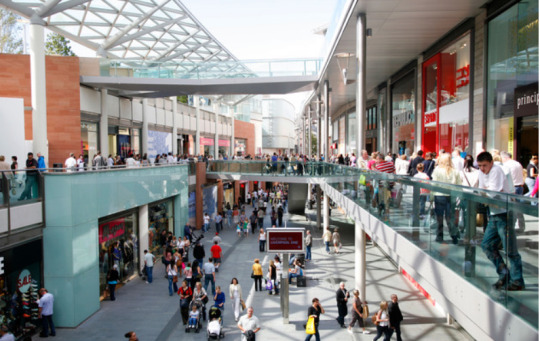
The Evolution of Local Shopping: How DASH Shop is Leading the Way
Shopping locally has always been more than just a transaction; it’s an experience. From the friendly banter with store owners to the joy of finding that perfect item, local shopping has been a cornerstone of community life. But as times have changed, so has the way we shop. Today, DASH Shop is at the forefront of this evolution, transforming local shopping into a seamless, technology-driven experience that blends the best of the past with the innovations of the future.
A Glimpse into the Past
Back in the day, local shopping was all about brick-and-mortar stores. People would stroll down Main Street, popping into their favorite shops, chatting with neighbors, and enjoying the tactile pleasure of seeing and touching products before buying them. It was a social activity, a chance to connect with others and support local businesses. However, as convenient as it was, this traditional model had its limitations. Store hours were fixed, inventory was finite, and sometimes the perfect item just wasn’t available.
The Modern Challenges
Fast forward to today, and the landscape of local shopping has drastically shifted. The rise of e-commerce giants has posed significant challenges for small, local retailers. With the convenience of online shopping, customers can browse endless aisles of products, compare prices, and have their purchases delivered right to their doorstep. This convenience has drawn many away from local shops, making it harder for small businesses to compete.
Local stores also face logistical hurdles such as managing inventory, offering competitive pricing, and meeting the high expectations of today’s consumers who demand quick, efficient service. The pandemic further accelerated these challenges, pushing even more shoppers online and leaving many local retailers struggling to stay afloat.
Enter DASH Shop: Revolutionizing Local Shopping
DASH Shop is here to bridge the gap between the traditional charm of local shopping and the modern demands of convenience and efficiency. By leveraging cutting-edge technology, DASH Shop is revolutionizing the local shopping experience in several key ways.
Instant Delivery:
One of the most significant ways DASH Shop is transforming local shopping is through its instant delivery service. Gone are the days of waiting weeks for an online order to arrive. With DASH Shop, customers can enjoy the convenience of having their purchases delivered to their doorstep within hours. This not only meets the high expectations of today’s consumers but also gives local retailers a competitive edge.
Robust Analytics:
DASH Shop provides retailers with powerful analytics tools, offering deep insights into sales trends, customer behavior, and inventory management. This data-driven approach helps retailers make informed decisions, optimize stock levels, and tailor their offerings to better meet customer needs. It’s like having a crystal ball for your business, ensuring you’re always one step ahead.
Seamless Integration:
One of the best parts about DASH Shop is its ability to integrate seamlessly with existing sales channels. Retailers don’t have to overhaul their entire system to benefit from DASH Shop’s features. Instead, the platform enhances current operations, adding value without disruption. This means smoother transitions and minimal hassle for business owners.
Community Engagement:
DASH Shop also helps retailers connect with their communities in meaningful ways. The platform supports local charities and community initiatives, fostering goodwill and strengthening community ties. By aligning with social causes, retailers can enhance their brand image and build customer loyalty.
Building Trust and Excitement
DASH Shop isn’t just a platform; it’s a movement. It’s about reimagining local shopping for the 21st century, combining the best of the old with the innovations of the new. By addressing the current challenges faced by local retailers and providing solutions that enhance the shopping experience, DASH Shop is positioning itself as a pioneer in local e-commerce.
So, whether you’re a retailer looking to boost your business or a shopper seeking convenience without compromising on community spirit, DASH Shop is here to lead the way. Join us in revolutionizing local shopping and experience the future today.
7 notes
·
View notes
Text
GIS In Our Daily Lives
The involvement of Geographic Information Systems (GIS) in our daily lives is pervasive, influencing and enhancing various aspects across different sectors. The integration of GIS into everyday activities has become integral for decision-making, planning, and optimizing resources. GIS helps city planners and transportation experts to provide them with information like maps, satellite pictures, population statistics, and infrastructure data. GIS helps them make better decisions when designing cities and transportation systems that are sustainable and good for the environment.
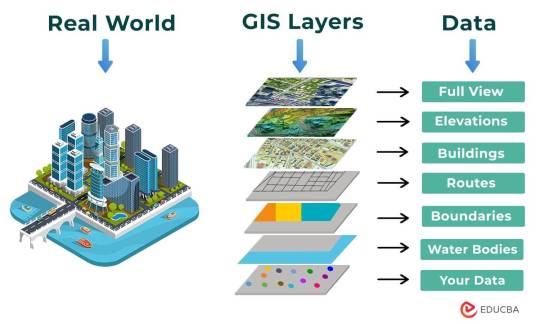
The following points elucidate the notable involvement of GIS in our daily lives:
Navigation and Location Services: GIS provides monitoring functions through the visual display of spatial data and precise geographical positioning of monitored vehicles, whereas GPS provides accurate, clear, and precise information on the position and navigation of a monitored or tracked vehicle in real-time and at the exact location.GIS is at the core of navigation applications and location-based services on smartphones. It enables accurate mapping, real-time navigation, and geolocation services, assisting individuals in finding locations, planning routes, and navigating unfamiliar areas.
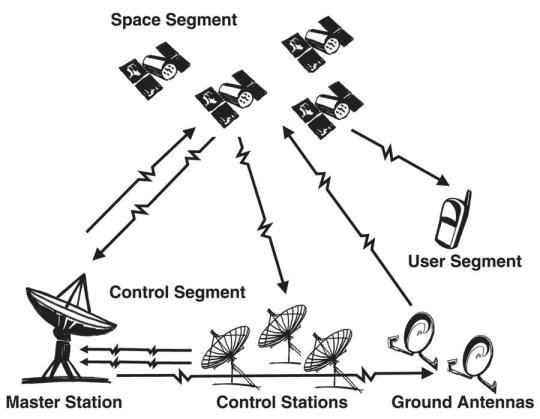
E-Commerce and Delivery Services: GIS software is a powerful tool for supply chain network planning. It helps determine the optimal location for distribution centers, warehouses, or other supply facilities. GIS is utilized in logistics and delivery services for optimizing routes, tracking shipments, and ensuring timely deliveries. E-commerce platforms leverage GIS to enhance the efficiency of their supply chain and last-mile delivery processes.
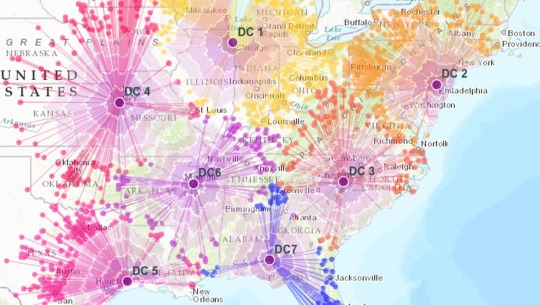
Weather Forecasting and Disaster Management: Many states are using GIS dashboard to monitor the rainfall across the state, on a real-time basis, from the data shared by rain sensors installed at various locationsGIS plays a crucial role in weather forecasting and disaster management. It assists meteorologists in analyzing spatial data, predicting weather patterns, and facilitating timely responses to natural disasters by mapping affected areas and coordinating emergency services.

Healthcare Planning and Disease Monitoring: Geographic Information Systems enable the visualization and monitoring of infectious diseases. Additionally GIS records and displays the necessary information that health care needs of the community as well as the available resources and materials. GIS supports public health initiatives by mapping the spread of diseases, analyzing healthcare resource distribution, and assisting in the planning of vaccination campaigns. It aids in identifying high-risk areas and optimizing healthcare service delivery.

Social Media and Geo-tagging: GIS also helps in geotagging and other location related information in posts, it’s tools can map and visualize the spatial distribution of social media activity. This analysis can reveal trends, hotspots, and patterns in user engagement across different geographic areas. Many social media platforms incorporate GIS for geo-tagging, allowing users to share their location and experiences. This feature enhances social connectivity and facilitates the sharing of location-specific information.
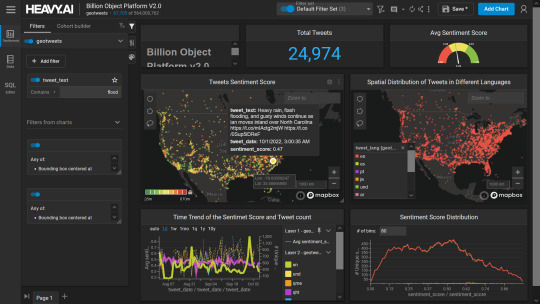
Smart City Initiatives: The Geographic Information System (GIS) offers advanced and user-friendly capabilities for Smart City projects and allows to capture, store and manipulate, analyze and visualize spatially referenced data. It is used for spatial analysis and modeling. It is the cornerstone of smart city planning, enabling the integration of data for efficient urban management. It supports initiatives related to traffic management, waste disposal, energy consumption, and overall infrastructure development.
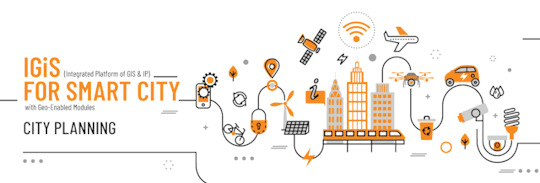
Education and Research: GIS is increasingly utilized in education and research for visualizing and analyzing spatial data. It enables students and researchers to explore geographic relationships, conduct field studies, and enhance their understanding of various subjects.

Agricultural Management and Precision Farming: Farmers leverage GIS to optimize agricultural practices by analyzing soil conditions, crop health, and weather patterns. Precision farming techniques, facilitated by GIS, contribute to increased crop yields and sustainable farming practices.

Real Estate and Property Management: In the real estate sector, GIS aids in property mapping, land valuation, and site selection. It provides real estate professionals with valuable insights into spatial relationships, market trends, and optimal development opportunities.

Tourism and Recreation: GIS enhances the tourism industry by providing interactive maps, route planning, and location-based information. It assists tourists in exploring destinations, finding attractions, and navigating efficiently.

The broad and varied involvement of GIS in our daily lives underscores its significance as a technology that not only facilitates geographic data analysis but also contributes to the efficiency, safety, and interconnectedness of modern society. As GIS applications continue to evolve, their impact on daily activities is expected to further expand and refine.
#gis#architectdesign#architecture#city#education#geographic information system(gis)#geographical indication
12 notes
·
View notes
Text

Starting an e-commerce business can be an exciting venture with immense potential. However, with the opportunities come challenges and uncertainties. Before diving into the world of online retail, it’s crucial to plan carefully and set a solid foundation. Here are some essential tips to consider before launching your e-commerce business:
1. Conduct Market Research
Understanding the market is fundamental to any successful business. Start by identifying your target audience and analyzing competitors. Research trends, customer preferences, and potential gaps in the market. Tools like Google Trends, social media analytics, and industry reports can provide valuable insights. This research will help you tailor your products or services to meet market demands and differentiate yourself from competitors.
2. Define Your Business Model
E-commerce offers various business models, such as B2C (Business to Consumer), B2B (Business to Business), C2C (Consumer to Consumer), and subscription-based models. Determine which model aligns with your goals and resources. Each model has its own set of challenges and requirements, so choose one that best fits your product or service and target market.
3. Create a Solid Business Plan
A comprehensive business plan serves as a roadmap for your e-commerce venture. Outline your business goals, strategies, target audience, marketing plan, financial projections, and operational plan. This document will not only guide your efforts but also help secure funding if needed. A clear plan can keep you focused and organized as you navigate the complexities of launching and running an e-commerce business.
4. Choose the Right E-Commerce Platform
Selecting the right e-commerce platform is crucial for the success of your online store. Popular platforms like Shopify, WooCommerce, Magento, and BigCommerce each offer unique features and capabilities. Consider factors such as ease of use, scalability, customization options, payment gateways, and integration with other tools. The platform should align with your business needs and provide a user-friendly experience for both you and your customers.
5. Develop a User-Friendly Website
Your website is the face of your e-commerce business. Ensure it’s designed to be user-friendly, visually appealing, and optimized for mobile devices. A clean, intuitive layout with easy navigation will enhance the shopping experience and reduce cart abandonment rates. Focus on high-quality images, detailed product descriptions, and a seamless checkout process. Additionally, implement search engine optimization (SEO) strategies to improve your site’s visibility in search engines.
6. Implement Secure Payment Processing
Security is a top priority in e-commerce. Customers need to trust that their payment information is safe. Choose a reputable payment gateway and ensure your website uses SSL certificates to encrypt data. Additionally, offer multiple payment options, including credit/debit cards, digital wallets, and other payment methods that are popular with your target audience.
7. Plan Your Logistics and Supply Chain
Efficient logistics and supply chain management are vital for e-commerce success. Develop a strategy for inventory management, warehousing, and shipping. Decide whether you’ll handle fulfillment in-house or partner with third-party logistics providers. Consider shipping options, delivery times, and costs. A smooth and reliable fulfillment process can significantly impact customer satisfaction and repeat business.
8. Craft a Marketing Strategy
Effective marketing is essential to drive traffic and sales to your e-commerce store. Develop a multi-channel marketing strategy that includes social media, email marketing, content marketing, and paid advertising. Create engaging content, run promotions, and leverage social media platforms to build brand awareness and attract customers. Monitor and analyze the performance of your marketing efforts to refine your strategies over time.
9. Focus on Customer Service
Exceptional customer service can set your e-commerce business apart from competitors. Provide multiple channels for customer support, such as live chat, email, and phone. Ensure timely responses to inquiries and resolve issues promptly. Building strong customer relationships and encouraging feedback can enhance customer loyalty and drive positive reviews.
10. Monitor and Adapt
The e-commerce landscape is constantly evolving. Regularly review your business performance, track key metrics, and gather customer feedback. Stay informed about industry trends and technological advancements. Be prepared to adapt your strategies and operations based on insights and changes in the market.
#ecommerce#marketing#business#digitalmarketing#ecommercebusiness#entrepreneur#onlineshopping#website#seo#webdesign#b#marketingdigital#onlinebusiness#branding#shopify#smallbusiness#socialmediamarketing#webdevelopment#online#amazon#shopping#onlinestore#onlineshop#design#ecommercewebsite#dropshipping
4 notes
·
View notes